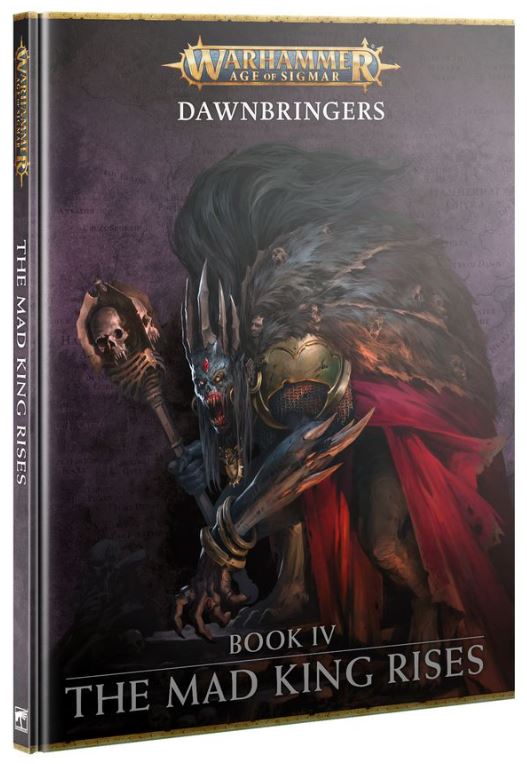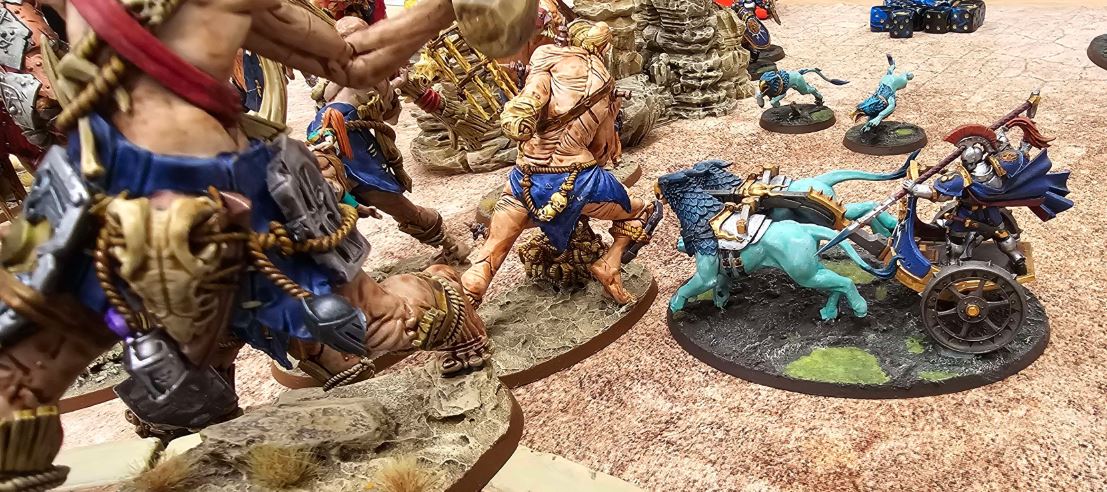We had a gaming day today at the local club and in my wee corner of the hall we broke out four Age of Sigmar armies for a multilayer Triumph and Treachery game. The rules for this sort of multiplayer game came from the fourth Dawnbringers book.

I took my Mancrusher-heavy Sons of Behemat army. I thought I’d give it another spin before the new edition makes the list unusable. The other players brought Stormcast Eternals, Slaves to Darkness, and Daughters of Khaine. I printed a bunch of snake-ladies for the latter player last weekend so that he’d have enough to use for today.
I also brought along a stack of index cards and pens to record our command points and ploys. In Triumph and Treachery, we start with a sizeable stack of command points; 50, in fact. These can be used through the game, as normal, but also have other functions which I will come to in due course.
A four player game has the potential to become unwieldy. We set up for the game, choosing the Rain of Stars battleplan which saw objectives added the the board as the game progressed, and had us each deploying in our respective corners of the board:

The way the game handles interactions between players is really interesting. Rather than having all players actively involved in every turn, it limits play to two players. The active player chooses another player at the start of their turn to be the opponent. All other players are, at that point, shut out of the game, with their models becoming neutral parties which cannot affect active players, or be affected by the active players’ miniatures. Ploys provide an exception to this but, again, I’ll come to those.
This limiting of player involvement actually works really well. It does mean more downtime for players, but it also means that turns don’t drag on forever. Imagine having all four players potentially involved in every combat phase during all four turns in a battle round, in a game consisting of four battle rounds. That’s sixteen turns. No. That would take way too long, with way too many overlapping abilities, buffs, auras, debuffs, and the like. Just, no. Having two active players per turn really makes this work.
And it’s not like the inactive (or neutral) players on a given turn are completely locked out. Let’s finally talk about ploys. Ploys are little abilities that you purchase with your many command points. They can be used to buff, debuff, or otherwise influence the game. Sometimes you’ll use them on your own models, and sometimes you’ll use them on opposing models. You might buy a ploy that, when played on a unit, including your own, gives a +1 to wound bonus. You might buy a ploy that lets you, as a neutral player, cut the charge distance of an active player’s unit in half to deny them a charge. You might go the other way and turn one of the active player’s charge dice into a 6. You could deny a command being issued, issue strikes first or strikes last, or otherwise improve or hamper combat, shooting, movement, magic, or a unit’s ability to hold an objective. There are loads of these things and they are great! You can keep three at a time, replenishing them at the start of a battle round, or by rolling a 6 (this is variable by the number of players) at the start of a turn as a neutral player.
How did our game go?
It was a total blast!
Initially, in our first turn, it felt like the game was going to be very much two regular games on the one board as the Sons of Behemat and Stormcast Eternals faced off, and the Daughters of Khaine took on the Slaves to Darkness. This had the potential to be a little disappointing, but we quickly realised that the ploys were a big part in stopping this sort of situation. One ploy, which cost 2CP allowed a player to deny the active player his first choice of opponent, forcing the game to go in a different direction. For example, the Stormcast player was denied a fight against the Sons of Behemat, so had to attack the Daughters of Khaine instead. This made the game more unpredictable and dynamic than it might otherwise have been.
The rule encourge dealmaking, and we saw a little of that. I offered command points in exchange for judicious and beneficial usage of ploys, though the rules also allow for me to trade victory points, if I wanted to. And, like, if I had any. It took me a long time to get my first points on the board! I spent too long trying to kill a dragon, I suppose.
The objectives turned out to be quite swingy, points-wise, as they were worth D6 victory points per objective, per turn. This meant that you could get anywhere from a single points to a massive six points for each objective. Our winning player managed to consistently roll 5s. The final score saw the Stormcast player score 27, whilst my Sons of Behemat scored 24, the Slaves to Darkness scored 13, and the Daughters of Khaine scored 11.
The best moment of the game was watching a 6 rounds, back-and-forth combat between a unit of snake ladies and some Stormcast. They just kept killing each other, fighting on death, killing each other again, and then fighting on death again. It was fantastic, and all four of us were cheering on that combat.
The Triumph and Treachery rules faciliated a fun game that was a lot cleaner and more streamlined than a straightforward free for all would have been. Limiting the active players to just two, but still allowing interaction through ploys, worked fantastically. We on’t expect to get another game of this in before the fourth edition of Age of Sigmar hits later this year, but we all agreed that we’d happily take these rules forward into the nenw edition. Nothing we’ve seen of AOS4 suggests that it would not be compatible with this system. If anything, having multiple multi-CP commands at our disposal would work better, but further diminishing our CP pool which did, on reflection, seem just a bit over-generous. I’m aware that my Stomper Tribe is a very CP-efficient army list, but none of us ended the game with fewer than 15CP left. Things could have been a bit tighter on the resource front.
All in all, I loved the game, and we all really liked the system. It worked well, was easy to pick up, and made for a really entertaining game. I think it helped that we had a group who didn’t take things too seriously. Now that the rules are known to us, I’d expect more negotiation and bargaining next time, too!
If you’re interested in trying out these rules for yourself, you can grab a copy of Dawnbringers IV: The Mad King Rises via this Element Games affiliate link.


2 Comments